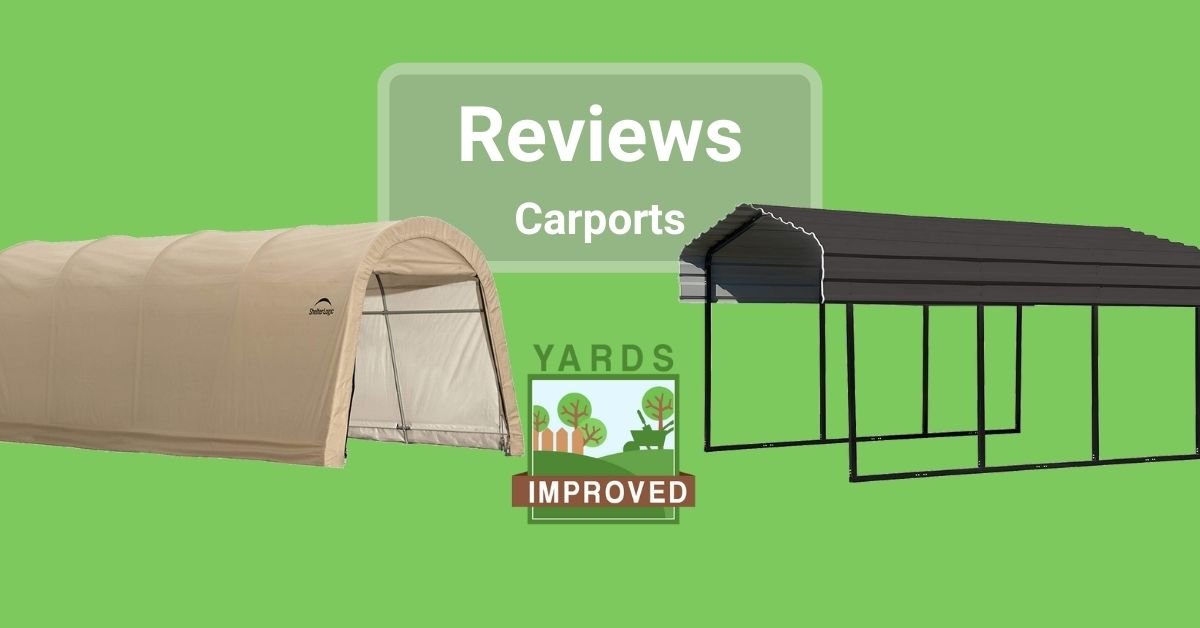No one wants to think of their car as “delicate,” but they can take quite a beating from the sun, the rain, dirt, and tree sap. If you prefer to keep your car looking great, you want it to have some shelter. When garage space isn’t available, a carport can be a good alternative.
Carports come in all styles and sizes. They can shelter vehicles of any size and may be permanent or temporary. Wood and metal are common materials for permanent ones. They can be costly, though. You also have to check local regulations to see if you can construct one. We’re not putting them down – they’re great!
Here, though, we’re going to look at lightweight, easy-to-set-up carports. They rarely require permits. You can put them up yourself, or maybe with a buddy or two to help. Of course, they’re not nearly as costly. But they can still be durable enough to hold up season after season, and keep your car from suffering from the weather.
Why You Need A Carport
The weather can be a terrible enemy to a car. If the car’s not sheltered, the sun’s UV rays strike it all day long. Nearby trees drip sap and drop leaves, twigs, and even small branches. Birds fly or perch overhead and – well, we know what the birds do.
A carport can help diminish these threats to your paint job and the external integrity of your automobile. All carports protect against overhead “hazards.” Some also have sides to offer protection from blowing trash, leaves, and dust.
Of course, a garage is a sturdier structure and provides 360° protection. But you may not always have space there. So a carport is a great backup for when you don’t have a garage available.
Metal vs. Polyethylene
You can find these temporary carports with metal or polyethylene roofs.
Aluminum is the most common metal used. Of course, that’s the more durable option. But it also carries a heftier price tag and is harder to assemble. It usually raises the temperature below the carport more, too. In general, an aluminum roof is louder during rainstorms or even when leaves and twigs fall on it.
Polyethylene carports have a metal frame, of course. But the roof is made of this popular synthetic material. If you live in a mild climate, it’s good. However, if you expect more than a dusting of snow, you’ll want to remove the roof. Otherwise, the weight of the snow could tear it down, and you could end up with a dent in your hood or roof. That could still happen with aluminum, but it’s less likely.
Carports with sides protect against the elements even more. Depending on the model, there could be anywhere from one to four sides (including a door, of course). This seems most common in ones that use polyethylene. You can choose to remove the sides when you like.
Choosing the Right Carport Size
Of course, you need a carport that’s the right size for your needs! And that depends on what kind of vehicle you have. A 2-door passenger car doesn’t need the same size carport as a Ford F-450 pickup.
Carports don’t all come in the same size. You need to check the dimensions carefully. That includes the width and height of the entrance (don’t forget to account for how far your side mirrors extend!). But you also have to make sure the carport is deep enough. Some longer vehicles might stick out of smaller carports!
Check your owner’s manual – or measure your car or truck yourself. Don’t forget to account for light racks or anything else on top of the vehicle, either. And be sure to look at the size of the entrance to the carport – not just the peak height or internal width.
Placing Your Carport
Of course, you have to make sure your carport will fit on your property, too. Besides that, there are several other things to look for.
You’ll want to erect the carport on hard, level ground. It doesn’t have to be on concrete or gravel, but it does require solid support to keep the frame correctly aligned. If you have a clear section of dirt, that’s fine.
Be sure not to put it where water tends to run, either. You don’t want to have a small creek form around your car every time it rains.
If possible, keep it away from large trees, too. Sure, part of the reason for having it is to protect against things falling from trees. But no carport is strong enough if a large branch falls.
Reviews of the Best Carports
We’ve looked around and have some recommendations if you’re interested in buying a carport. We found these to be quality options, and that seems to be echoed by other purchasers.
We’ve chosen to concentrate on single-car carports. However, there are also many good ones for two or three cars.
Abba Patio 10 x 20 ft Carport

This sturdy carport not only protects your car but also looks great. You may even want to use it as a cover for get-togethers!
At ten feet wide by 20 feet deep, most passenger cars will fit into it comfortably. The entrance is 6 feet high, which precludes a lot of SUVs and trucks, though. Also, you may have to duck going through the entrance.
This does include sides, and they’re fitted with beautiful faux windows. That is, they don’t open and can’t be seen through. However, they do make it look charming! It is pretty easy to add or remove the sides, though. The front entrance consists of two panels that can be rolled up and tied in place.
There are eight steel legs. This provides a lot more stability than many competitors, which frequently have only six.
The pitch of the roof is kind of steep, so snow usually slides right off. That’s another big advantage.
However, like most carports with polyethylene sides and roof, this one may not hold up in high winds. Even at 45 mph, it can be problematic. We suggest removing the sides if you expect that kind of condition, but even then the roof could tear off.
It’s available in white, ivory, gray, and khaki.
Quictent 10’x20’ Carport
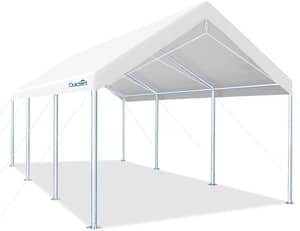
Quictent makes this polyethylene-covered carport, and they make it well.
It measures 10 by 20 feet. The peak height is 8.7 feet and the sides are 6 feet. So cars will fit easily but if you’re tall, you may have to duck as you get out.
There are no sides to this model, but it offers good protection from the sun’s rays as well as rain and snow.
The poles are galvanized steel. There are eight altogether, and the corner four are anchored to the ground with cables. Honestly, we’re not particularly happy with this. It does offer a lot of stability, but it also means you lose more space on either side of the carport. And be sure you don’t forget and trip over them.
According to their Amazon listing, this is an improved model. The upgrade seems to be the galvanized steel poles. The original model had aluminum poles which didn’t hold up as well.
Overall, we found this to be a high-quality tent. Like any, it will face issues with strong winds. But that’s to be expected.
ShelterLogic Peak Style AutoShelter
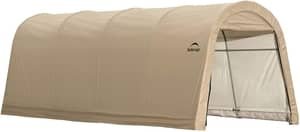
ShelterLogic’s carport is another strong competitor in the field. It’s available with either a rounded roof (pictured) or a peaked version.
You can also choose between two sizes. Both are 10 feet wide and 8 feet high. One is 15 feet deep and the other 20.
The polyethylene material is durable and fits well over the metal frame. It has a total of 8 legs.
The sides are not removable on this carport.
The kit includes four anchors to attach it to the ground.
It does a reasonably good job of letting snow slip away. Be sure not to let it accumulate more than a few inches, though, to avoid sagging panels.
It’s a 6- to 8-hour job for two people to set up.
From reports we’ve seen, it seems to hold up to the cold better than extreme heat. People in the north had better experiences than users in Nevada and Arizona, for instance.
ADVANCE OUTDOOR Adjustable 10×20 ft Heavy Duty Carport
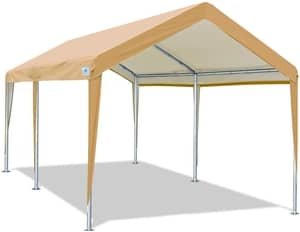
This open-sided carport will provide stable protection for your car from overhead threats. It’s a standard 10 foot by 20 foot. The peak height is adjustable from 9.5 to 11 feet. The side height – which is what really matters for your vehicle – can be set from 6.5 to 11 feet, allowing plenty of clearance even for taller vehicles.
Six alloy-steel legs hold it up. It’s still pretty stable even though it has fewer legs than some of the other leading models.
Each leg goes through a round base, and each base is held to the ground with two pins. It does a decent job of holding it in place.
It’s easy to assemble and should take a short afternoon for two people to finish.
As usual, it is subject to trouble with winds over 40 miles per hour.
Arrow Carport
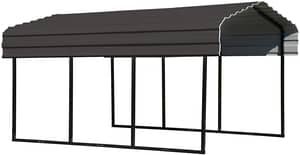
We wanted to include at least one metal-covered carport, and we found this model from Arrow to be a great choice.
It measures 10 by 15 feet. It’s 7 feet high at the sides and about 9 feet in the center. The poles are two inches square.
This outdoes all the polyethylene competitors when it comes to withstanding wind and snow, of course. It’s also about twice as heavy, which you’d expect. That’s not a drawback at all, as it helps it to stay in place. But it might take a little extra help to install.
The roof of this model is 29-gauge galvanized steel. The manufacturer claims a 100 mph wind load rating.
Arrow also offers tarpaulin siding for this model.
Conclusion
A carport is a good way to protect your car from damage and fading paint due to the weather. For many people, a temporary structure is more suitable than a permanent one. Be sure to find one that fits your available space and your vehicle. Of course, you also want it to be suited to the weather in your area! Adding a carport is an investment and can help extend the useful life of your vehicle.

